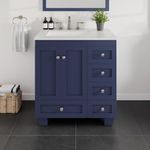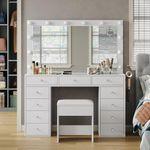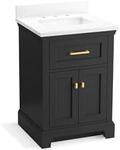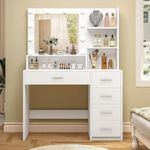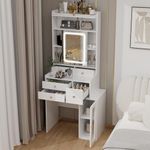Buying Guide for the Best vanities
When choosing a vanity for your bathroom, it's important to consider both functionality and aesthetics. A vanity is not just a piece of furniture; it serves as a storage solution and a focal point in your bathroom. To make the best choice, you need to evaluate several key specifications that will ensure the vanity meets your needs and complements your bathroom's design. Here are the key specs to consider and how to navigate them.SizeSize refers to the dimensions of the vanity, including its width, depth, and height. This spec is crucial because it determines how well the vanity will fit in your bathroom space. To navigate this, measure the available space in your bathroom and consider the layout. Vanities come in various sizes: small (under 24 inches), medium (24-48 inches), and large (over 48 inches). Choose a size that fits comfortably in your space without overwhelming the room or obstructing movement. If you have a small bathroom, a compact vanity will be more suitable, while larger bathrooms can accommodate bigger vanities with more storage.
StorageStorage refers to the amount and type of space available for keeping your bathroom essentials. This is important because it helps keep your bathroom organized and clutter-free. Vanities can have drawers, cabinets, or open shelves. To navigate this, think about what you need to store. If you have a lot of toiletries and towels, look for a vanity with ample cabinet space and multiple drawers. For minimal storage needs, a vanity with a few drawers or open shelves might suffice. Choose a vanity that offers enough storage to keep your bathroom tidy and functional.
MaterialMaterial refers to the type of wood, metal, or composite used to construct the vanity. This spec is important because it affects the durability, appearance, and maintenance of the vanity. Common materials include solid wood, MDF (medium-density fiberboard), plywood, and metal. Solid wood is durable and has a classic look but can be expensive. MDF and plywood are more affordable and come in various finishes but may not be as durable as solid wood. Metal vanities offer a modern look and are easy to clean but can be prone to rust. Choose a material that fits your style preferences and maintenance capabilities.
Sink TypeSink type refers to the design and installation method of the sink that comes with or is compatible with the vanity. This is important because it affects the overall look and functionality of the vanity. Common sink types include undermount, drop-in, vessel, and integrated sinks. Undermount sinks are installed below the countertop for a seamless look, while drop-in sinks sit on top of the counter and are easy to install. Vessel sinks sit on top of the counter and add a stylish touch, but they may require more cleaning. Integrated sinks are built into the countertop for a sleek, easy-to-clean option. Choose a sink type that matches your aesthetic preferences and practical needs.
StyleStyle refers to the design and aesthetic of the vanity, including its color, finish, and overall look. This spec is important because it determines how well the vanity will blend with your bathroom decor. Styles range from traditional and rustic to modern and contemporary. To navigate this, consider the existing design elements in your bathroom. Traditional styles often feature ornate details and rich finishes, while modern styles are sleek and minimalist. Rustic styles use natural materials and finishes for a cozy feel. Choose a style that complements your bathroom's decor and reflects your personal taste.
Installation TypeInstallation type refers to how the vanity is mounted in your bathroom. This is important because it affects the ease of installation and the overall look of the vanity. Common installation types include freestanding, wall-mounted, and corner vanities. Freestanding vanities are the most common and easy to install, as they simply sit on the floor. Wall-mounted vanities are attached to the wall, creating a modern, floating look and saving floor space, but they require more complex installation. Corner vanities are designed to fit into a corner, making them ideal for small bathrooms. Choose an installation type that suits your bathroom layout and your DIY skills.
